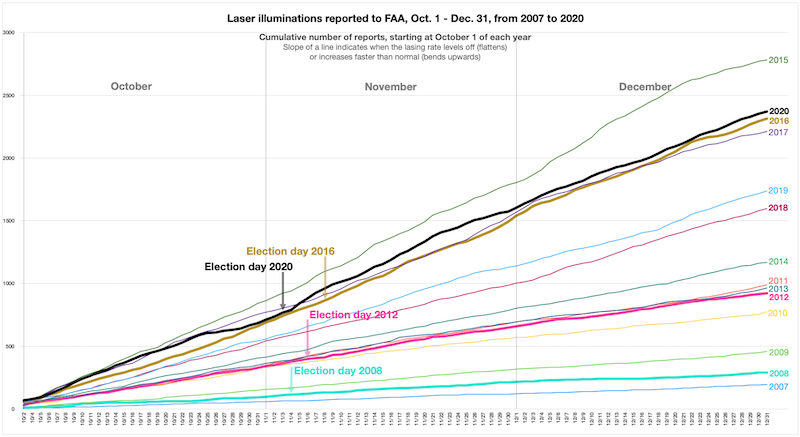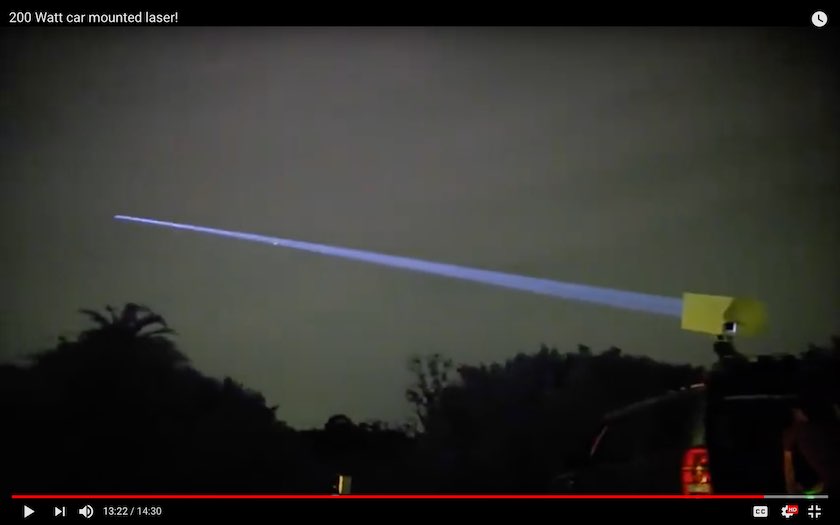Home
A comprehensive resource for safe and responsible laser use
Italy: Laser pointer used at Venice film festival to point out viewers without masks
"Mask-wearing was one of the most assiduously policed protocols; even mid-row offenders were publicly shamed by being immediately targeted with a red laser pointer, which must have felt like being in the sights of a sniper."
From the New York Times
COMMENTARY FROM LASERPOINTERSAFETY.COM
This is an interesting practical use for laser pointers. Of course ushers should only use a low-powered "bullet" type pointer like those sold in pet stores, that take two or three hearing-aid style batteries. Care should be taken to avoid the eyes. If the beam from a small Class 2 (less than 1 milliwatt) laser accidentally goes into a person's eyes, there would be a bright flash but no injury or damage.
US: FAA webpage analyzes laser strike statistics
It includes graphs of yearly, monthly and daily laser event numbers, data on events by month and by day of the week, states ranked by raw numbers and on a per capita basis, injuries, and altitudes at which lasers were seen. By clicking on data points or sections of a chart, a box pops up with more precise information.
Here is the top part of the webpage as it appeared in September 2021:
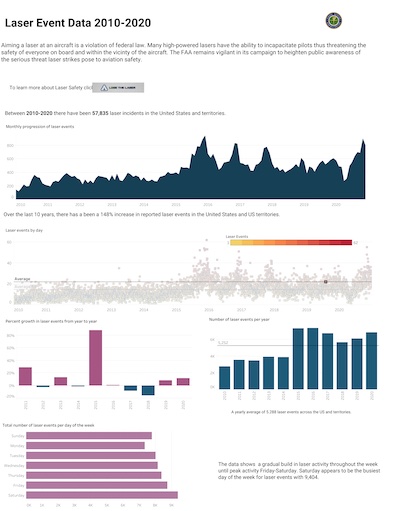
From FAA's data visualization webpage. If this link does not work, the data might also be accessed from FAA's main laser safety webpage. T
COMMENTARY FROM LASERPOINTERSAFETY.COM
Many of the FAA charts on the webpage are very interesting, such as the number of laser events per capita for each state. For example, Hawaii leads the country in laser illuminations per capita, in 2020.
However, some charts are near useless such as the "injuries" chart. This is organized by state, not by type of injury. Worse, there is no information provided about what counts as an injury, or the severity and outcome of the reported injury. (We have our own injury analysis chart on this page which is much more detailed.)
Another near-useless FAA chart is one that shows aircraft altitude during the incident. The chart shows data points with the number of flights at a given altitude. But there is no attempt to group altitude ranges together, for example, to find out how many laser incidents happened between 0-1000 ft, between 1000-2000 ft, etc. 
In contrast, this chart (done by LaserPointerSafety.com) has the same data formatted in a more understandable way:
US: Why did lasers aimed at aircraft increase after the 2020 election?
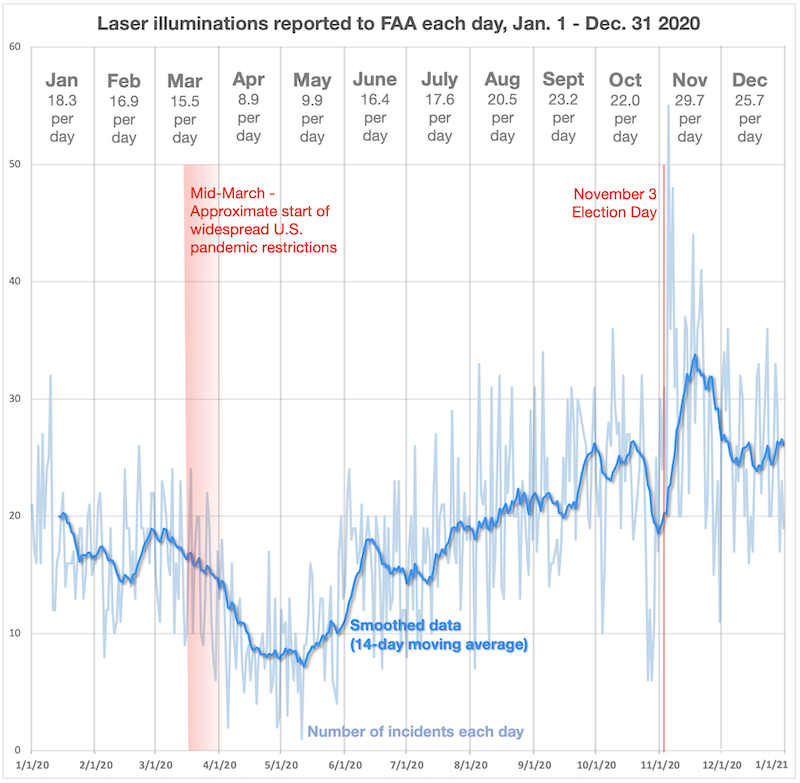
In fact, of the 10 highest days (most incidents) in 2020, all but one occurred in the Nov. 5-21 period. There were 55 incidents on Nov. 5, 48 on Nov. 6, 44 on Nov. 17, and 41 on Nov. 21. These occurred more than twice as often, compared with the 2020 average of 18.7 incidents per day.
Is this a statistical anomaly or did the disputed election results somehow lead to an increase in laser incidents?
COMMENTARY AND ANALYSIS BY LASERPOINTERSAFETY.COM
The chart below indicates that the three previous U.S. presidential elections did not have an effect on lasing incident rates.
It shows that in 2008, 2012, and 2016 the number of laser incidents each day between October 1 and Dec. 31 rose smoothly and steadily. In contrast, the lasing rate in 2020 (black line) slowed substantially around October 26, and rose significantly just after Election Day on November 3.
However, these two effects appear to counter each other. It may be that some other factor, such as how FAA records or processes laser incident reports, slowed in late October and sped back up in November.
In summary, while it is tempting to say that agitation over the 2020 election results led to an increase in persons aiming lasers at aircraft, this was not seen in previous election years and may be a statistical anomaly.
US: New federal law makes aiming laser at watercraft a felony
The provision was added as part of the National Defense Authorization Act for FY2021, which became law on January 1 2021. It will be added to Title 46 United States Code, Chapter 700, Subchapter II, section 70014 entitled "Aiming laser pointer at vessel."
The law lists exceptions: "This section shall not apply to a member or element of the Department of Defense or Department of Homeland Security acting in an official capacity for the purpose of research, development, operations, testing, or training."
It also defines laser pointer as follows: "In this section the term `laser pointer' means any device designed or used to amplify electromagnetic radiation by stimulated emission that emits a beam designed to be used by the operator as a pointer or highlighter to indicate, mark, or identify a specific position, place, item, or object.''
According to the U.S. Coast Guard Investigative Service, "[o]ffenders who target a Coast Guard vessel with a laser pointer and harm an officer can receive up to $25,000 in civil fines, and criminal penalties can include up to 25 years imprisonment."
Text of the Enrolled Bill is available from Congress.gov. As of January 27, 2021 the text of the Public Law 116-283 has not been uploaded. Comments by the CGIS are from an article in The Maritime Executive.
COMMENTARY FROM LASERPOINTERSAFETY.COM
This is the maritime version of the February 2012 law prohibiting aiming laser pointers at aircraft, U.S.C. Title 18, Chapter 2, Sec. 39A. There are some interesting differences.
The 2021 maritime law prohibits a beam from striking a vessel on the navigable waters. The 2012 aviation law prohibits aiming at an aircraft or at the flight path of an aircraft. Apparently aiming at a maritime vessel would not be illegal unless it struck the vessel.
The 2021 maritime law has one exception, for the Defense or Homeland Security departments. The 2012 aviation law has four exemptions. The first is for FAA, aircraft manufacturers, and FAA-authorized persons doing research or flight tests. The second is identical to the 2021 DoD and DHS exemption. The third exemption is for persons using a laser emergency signaling device to send a distress signal. The fourth allows the Justice Department in consultation with the Department of Transportation to provide additional exemptions; these are not considered or allowed under the 2021 law.
Both laws, 2021 and 2012, have an identical definition of "laser pointer."
US: YouTuber makes 200 watt car-mounted laser, aims into sky
The video was done by 29-year-old Sarasota, Florida resident Kevin Kohler, who uploads as TheBackyardScientist on YouTube (4,500,000 subscribers) and who is on Twitter as @ChemicalKevy.
In the video, he states "As normal, you should never shine a laser into the sky. But we've checked the flight radar and there's no airplanes in 100 miles that direction."
(Click the link for more additional safety information)
Switzerland: Laser pointers above Class 1 banned as of June 1 2019
As of June 2019, this is the most restrictive laser pointer law of any major country; Class 2 pointers (up to 1 milliwatt) are legal in most countries, and Class 3R pointers (up to 5 milliwatts) are legal in the U.S.
Travelers should note that laser pointers and "hybrid devices" above Class 1 that are being transported into or through Switzerland can be confiscated before entering Swiss borders. For example, a wireless mouse used for PowerPoint presentations, such as the one shown below could be confiscated if it contains a laser above Class 1.
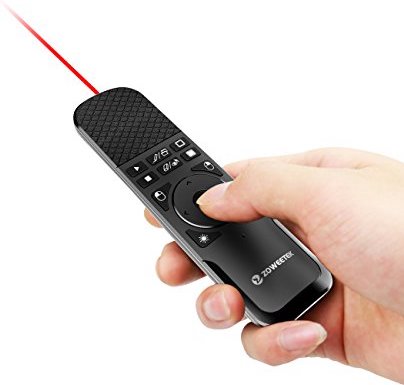
The Swiss ban applies to all laser classes above Class 1 (1M, 1C, 2, II, 2M, 3a, IIIa, 3R, 3B, IIIb, 4 and IV) as well as pointers with no labels or markings. These are all defined as "dangerous pointers" by the Swiss Federal Office of Public Health.
Persons in Switzerland who currently possess "dangerous pointers" except for Class 2 must cease to use them beginning on June 1 2019, and must dispose of them as electrical waste before June 1 2020.
Persons possessing Class 2 pointers can use them indoors only for presentations until June 1 2021, by which time they must be disposed of as electrical waste.
"Laser pointer" is defined as "a hand-held laser that can be used to point to things, for amusement (as a toy or in hobbies), to scare off animals or drive away other people."
More information appears below.
US: FAA credits "heightened public awareness" for lowering laser incident numbers in 2017 and 2018
Incidents reported to FAA have declined from 7,398 reports in 2016, to 6,754 reports in 2017, and 5,663 reports in 2018, the last full year for which statistics are available.
According to FAA, "the agency and law enforcement agencies are working hard to increase public awareness of the dangers posed by lasers."
The news item linked to a page entitled "Laser Incidents and Legal Interpretation of the Law", a new video published April 10 2019 on YouTube, entitled "Laser Strikes on Aircraft Pilots", and an April 10 2019 Fact Sheet on lasers.
One paragraph of the fact sheet says that "The FAA’s guidance for agency investigators and attorneys stresses that laser violations should not be addressed through warning notices or counseling. The agency seeks moderately high civil penalties for inadvertent violations, but maximum penalties for deliberate violations. Violators who are pilots or mechanics face revocation of their FAA certificate, as well as civil penalties."
From FAA news item "Outreach Helps Bring Laser Strike Numbers Down"
COMMENTARY FROM LASERPOINTERSAFETY.COM:
We are not aware of any recent (2015-2018) campaign by FAA to increase public awareness.
In 2014, there was a publicity campaign by the Federal Bureau of Investigation (FBI) in 12 U.S. cities between February 11 and April 11 2014, which offered a $10,000 reward for information about anyone pointing a laser at an aircraft. This was expanded nationwide between June 3 and September 1 2014. During 2014 there was a 12.8% decline in laser incidents compared to 2013. It is not known how much the FBI publicity campaign contributed to the decline.
In our view, there may be other reasons for the decline. For example, pilots may be tiring of reporting laser illuminations with no apparent follow-up or effect. This would lead to a decline in reported incidents.
We are not aware of any studies done to determine the reasons for declines in reported laser incidents.
To summarize, it seems incorrect to attribute the lower number of laser incidents to "heightened public awareness." In fact, there is some anecdotal evidence that publicity actually leads to copycat laser incidents.
US: Video shows tattoo removal laser damaging $2200 consumer camera
In March 2019, a YouTube video showed laser tattoo removal damaging a high-end digital camera sensor just by taking a video of the laser pulses on the skin.
The laser beam did NOT directly enter the Sony A7SII lens. And yet with every tattoo removal pulse of the green laser, the camera sensor was obviously damaged. According to the person posting the video, "The repair cost was about as much as a new camera [about $2200] so try to avoid this."
If a laser is powerful enough, just looking at the dot of the laser on a wall can be a "diffuse reflectance hazard." In this case, the reflected laser light was powerful enough to damage the sensor.
This is not a flaw in the laser or the camera. As described elsewhere, camera sensors are generally more sensitive than the eye.
Also as noted, different cameras may have different sensitivities depending on many factors. For example, this page includes four YouTube videos showing laser tattoo removal, without any apparent damage to the video sensor.
Laser pointers and handheld lasers are almost always emit continuous wave light. CW lasers can damage the retina by heating it up, while pulsed lasers create an "acoustic shockwave" which instantly causes a popcorn-like explosion in the retina.
According to this page, a typical tattoo removal laser has a maximum pulse energy of about 1-2 Joules and a pulse width of about 5-10 nanoseconds. It is not known how powerful the laser was in the video.
Everyone in the room should have been wearing laser safety glasses or goggles that reduce the laser light to safe levels. If the camera had been shooting through the safety glasses' lens, the damage likely would not have occurred.
From various sources including Reddit, Digital Photography Review, Petapixel, and SlashGear
Switzerland: Class 1 limit (0.39 mW) on sale, possession of laser pointers is proposed
According to FOPH, “An increasing number of laser pointers has been placed on the market that pose a danger to human health and to pilots or locomotive drivers. In order to avoid both dangerous glare and direct eye damage in the future, only class 1 lasers pointers will be allowed to be placed on the market.”
Comments are requested by October 5 2018. The proposed date of adoption is March 1 2019, and the proposed date of entry into force is January 1 2020.
The O-NIRSA draft ordinance is available in German, French and Italian. The current Federal Act on Protection Against Hazards Arising from Non-Ionising Radiation and Sound (NIRSA) is available in German, French (no link), Italian (no link) and English.
We were not able to find a link for the submission of comments; you may want to check with the Swiss Federal Office of Public Health (FOPH) and/or the Swiss Association for Standardization (SNV).
From an item in the August 2018 ESTA Standards Watch
Commentary from LaserPointerSafety.com: If adopted, a Class 1 limit would be the strictest in the world. There are many countries that have a Class 2 (1 milliwatt) limit on laser pointers, and some that have a slightly higher Class 3R limit (5 milliwatts).
For red laser pointers, Class 1 would make them barely visible under normal classroom or presentation scenarios. Because green light appears brighter to the human eye, a Class 1 laser pointer may be acceptable. However, LaserPointerSafety.com has never seen a Class 1 laser pointer.
Canada: Restrictions on high-powered handheld lasers in three cities
Persons are banned from possessing such lasers outside of their home, without a legitimate purpose such as work, school, education or astronomy.
Police can question anyone with a laser in one of the prohibited zones if they had a reasonable reason to search them. Examples given included if a member of the public contacted police with a specific description of a person they saw holding a laser, or if police themselves saw the person holding a laser.
Any person with a battery-operated, handheld laser in a prohibited zone 1) outside of a private dwelling and 2) without a legitimate purpose could be fined immediately and “on the spot” up to CDN $5,000. A corporation violating the law would be fined up to CDN $25,000. The fines are in addition to any criminal prosecution; intentionally aiming a laser at an aircraft could result in five years in prison and/or up to CDN $100,000 in fines.
According to Transport Canada, “You don’t need to carry any documentation, but you should be prepared to demonstrate to the officer why you’re in possession of a hand-held laser. Law enforcement will be trained to know when and where people may possess a laser. They will exercise their discretion and judgement when determining whether or not to issue a fine.”
Transport Canada has a webpage with details of the laser prohibitions, a question-and-answer page about the new laser safety measure, and an online forum “Let’s Talk - Lasers” seeking feedback on laser safety issues. The “Let’s Talk - Lasers” consultation closes for comments on August 27 2018.
They also have an online interactive map detailing the prohibited zones. Here are two examples of map output:

Laser-prohibited zones in the entire country
Closeup of laser-prohibited zones in the Toronto area
The three metro areas of Montréal, Toronto and Vancouver were included since, according to Transport Canada, “The majority of reported laser attacks have occurred in these regions. Transport Canada will continue to monitor the number and location of reported incidents and may adjust the included municipalities as warranted.”
The agency discussed how the fines were determined, and how law enforcement will decide on the exact fine amount: “These fines, called administrative monetary penalties, come from the Aeronautics Act and the Canadian Aviation Regulations. Law enforcement uses discretion on how much to fine an individual. The amount may depend on previous infractions and circumstances surrounding this infraction.”
When concluding his announcement, Garneau stated “we have the tools that law enforcement agencies need, including Transport Canada inspectors and police forces, in order to put an end to these careless and reckless actions — actions that could have tragic results.”
From the Canadian Press, the CBC, iPolitics, a video of Marc Garneau’s announcement on GlobalNews.ca, and the Transport Canada informational webpage and Q&A webpage.
For much more information and commentary from LaserPointerSafety.com:
US: Advisory committee recommends pilot procedures, training and glare protection
ARP6378™ has three main parts:
- A description of how lasers can interfere with pilots’ vision and operational performance, and how pilots can reduce adverse effects.
- A recommendation for pilot training, including exposure to safe, simulated laser light in a simulator or other realistic flying environment
- A description of Laser Glare Protection eyewear and windscreen film, with recommendations for whether and how to use these.
The document was developed by the SAE G10OL “Operational Laser” committee over a two-year period. It is available for purchase from SAE for $78. A three-page preview, which includes most of the Table of Contents except the appendices, is here.
From SAE ARP6378™, “Guidance on Mitigation Strategies Against Laser Illumination Effects”, published June 2 2018. Available from SAE.org.
Click to read more...
US: High-powered lasers can be obtained from inside a Christmas holiday laser projector
In a January 22 2018 Hackaday post, Tom Nardi purchased a “Home Accents Holiday Multi-Color Light Projector” from a hardware chain on clearance, marked down from $56 to just $14.
He removed the cover with four screws and found the parts inside used connectors instead of solder: “It’s like they wanted us to strip it for parts.”
The lasers were defocused inside. “…[A]t 3 meters the spots looked as large as dinner plates…. Once focused, it becomes pretty clear that these lasers are quite a bit more powerful than the <5 mW listed on the product’s warning sticker.”
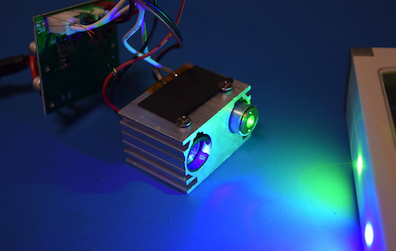
The green and blue laser diode modules inside the holiday projector
Nardi noted that the blue laser, when focused, was “easily able to burn pieces of paper and punch holes in black plastic.” He also estimated that the green laser was “at least twice as bright” as a laser pointer he owns that claims to be 50 mW: “…it certainly would not surprise me if they are both [green and blue] at least 100 mW.”
Nardi writes: “If your biggest take-away from this post is that the Home Depot is selling a 440 nm laser you can use to burn stuff, I certainly don’t blame you.”
From Hackaday. LaserPointerSafety.com has a page with more information, including measurements of the beam output of a Star Shower projector, here.
Commentary from LaserPointerSafety.com: In fairness to Home Accents, the FDA-required warning sticker has to do with the laser power of the unopened unit in its factory configuration. Class 3R (IIIa) laser projectors like this are not allowed in the U.S. to be over 5 mW output power. It may be that after going through the holographic diffraction grating that creates the stars, that the Home Accents projector meets Food and Drug Administration requirements for user access to laser light.
UK: "Call for evidence" response summarizes many groups' views on laser eye, plane incidents; sets forth actions
The U.K. government published on January 8 2018 a 14-page report on laser pointer safety and potential regulation. The report includes two new actions the government will take to reduce the number and risk of unsafe laser pointers:
1) “strengthening safeguards to stop high-powered lasers entering the country”, and
2) “working with manufacturers and retailers to [voluntarily] improve labeling.
Separately, the U.K. government published the Laser Misuse (Vehicles) Bill on December 20 2017. This makes it illegal to point a laser at vehicles, with a prison term of up to five years and an unlimited fine.
“Laser pointers: call for evidence - government response”
From August 12 to October 6 2017, the Department for Business, Energy and Industrial Strategy opened a “Call for Evidence” consultation. BEIS set forth 19 questions, asking the public to give their views on laser pointer hazards and what actions to take.
The January 8 2018 government response summarizes the 265 responses received.
The report is especially useful because it incorporates the views of many disparate groups: pilots (64% of respondents), “concerned members of the public” (14%), professional laser safety advisors (9%), users of laser pointers (6%), ophthalmologists (6%), and Trading Standards authorities (2%).
The report then distills these views, finding surprising commonality. It is a good overview for the non-expert on two topics:
1) Actual laser pointer hazards — separating fact from fear
2) Potential actions to reduce the number and severity of laser pointer injuries and incidents — including what actions may not work (e.g., licensing).
We have summarized the findings below (click the “read more” link). However, reading the complete document is well worth the time of anyone interested in this issue.
Click to read more...
US: UPDATED - FDA wants to allow only red laser pointers, calling all other colors "defective"

FDA’s primary concern is green lasers’ interference with the vision of vehicle operators including pilots. Green lasers are involved in over 90% of incidents where pilots reported to the Federal Aviation Administration (FAA) that they saw or were illuminated by laser light during a flight. (The charts below were added in January 2017 after the 2016 FAA final numbers came out.)
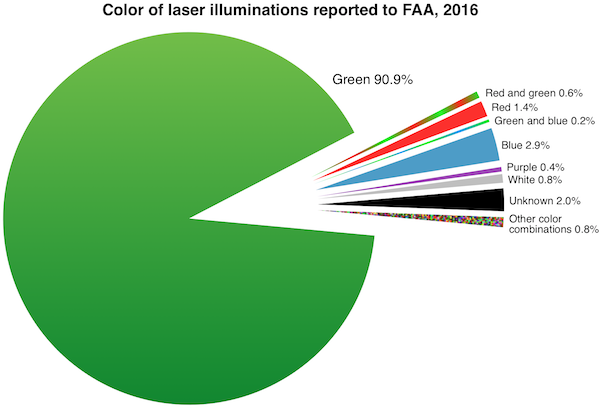
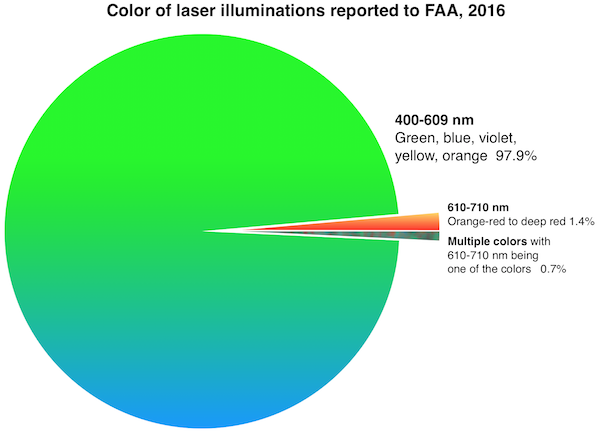
FDA is also worried about blue lasers which can have greater visibility to night-adapted eyes than red lasers of equivalent power.
Thus FDA is applying the “defective” label — giving them added authority over potentially injurious products — because of what they consider to be a well-known, established public safety hazard to operators of vehicles, aircraft and watercraft.
What FDA is trying to accomplish
FDA has two main goals:
1) “Turn back the clock” to the 1990s and early 2000s when almost all laser pointers were red. According to the agency, red light has the least interference with pilot vision, compared to equivalent-power green beams which can appear up to 28 times brighter. During this period there were dozens or low hundreds of reported laser/aviation incidents per year, compared with 7,703 incidents in 2015 and 7,442 incidents in 2016.
2) Make it much easier for customs and law enforcement to identify illegal laser pointers simply by their color. Red and orange-red laser pointers would be permitted; all others would be prohibited for general sales.
In addition, FDA sought to address requests from legislators including Senator Chuck Schumer (D-NY). After high-profile incidents, lawmakers have written to FDA, asking for a ban on green pointers due to their vision-blocking abilities being a risk to pilots and passengers.
Who would be affected
FDA’s proposed color-based prohibition would only affect the manufacture, importation and sales of laser pointer products introduced into commerce. Although pointers fall under the FDA’s “surveying, leveling and alignment” (SLA) control, only pointers as defined by FDA would be restricted to red. Standard SLA equipment would not be affected — they could use any color beam.
Individuals such as hobbyists who manufacture their own laser products for their personal use would be free from FDA laser product regulations. This is because such individuals would not be considered manufacturers by FDA.
Since federal law cannot control individual use or misuse, states and localities could impose their own regulations. (A few states and localities already have their own restrictions on use and/or possession; these are not currently based on the color of the laser.) One benefit of FDA’s proposal is that any new state and local laws could “piggyback” on FDA’s color-based restrictions. That would make it easier for local law enforcement to use color to easily identify whether a person possessed a prohibited or permitted laser.
FDA’s proposal and rationale was stated in draft amendments presented October 25 to an FDA advisory panel known as “TEPRSSC”.
Click to read more...
International: Over 10,000 air rage incidents worldwide in 2015 (not a laser)
In 11 percent of incidents, there was “physical aggression towards passengers or crew, or damage to the aircraft,” IATA reported.
IATA’s Director General stated “There is no easy answer to stem the rise in reported unruly behavior. We need a balanced solution in which all stakeholders can collaborate. The industry’s core principles can help to manage the small percentage of passengers who abuse alcohol. And it must be balanced with efforts by governments taking advantage of all their deterrence mechanisms….”
From a September 28 2016 press release from the International Air Transport Association. LaserPointerSafety.com is publishing this as an interesting comparison with the number of worldwide incidents of laser illuminations of aircraft, which are roughly on the same order of magnitude as that of air rage incidents.
UK: Arrest persons carrying "high-powered" laser pointers in public, says top aviation regulator
According to Haines, laser attacks have permanently damaged pilots’ vision, and it is conceivable that they could cause an aircraft crash. In 2015 there were 1,439 laser incidents reported to CAA.
Haines said there is no legitimate reason for a person to have a high-powered laser pen in public. Press reports did not indicate Haines’ definition of “high-powered”. (In the U.K., lasers used as pointers are limited to 1 milliwatt [the U.S. limit is 5 mW], so it is possible that “high-powered” would mean any handheld laser above 1 mW.)
Haines asked “Why does Joe Bloggs walking down the street need a laser that can pop a balloon at 50 miles, that can cause permanent damage to a pilot?”
The CAA chief wants new, restrictive legislation because at present, it is difficult to find laser perpetrators and to prove they had intent to endanger aviation, under the Air Navigation Order 2009.
A U.K. government spokesperson said "We take this issue very seriously and we continue to work with other Government departments, the CAA and industry to determine how best to control the sale, use and possession of laser pens. We are looking to make changes as soon as possible."
From the Daily Mail, BBC, the Mirror, and other news sources. For commentary about Haines’ statements, click the “Read More…” link below.
Click to read more...
UK: UPDATED - Medical report on commercial pilot injured by blue laser at 1300 feet
“An airline pilot presented to our department complaining of a blind spot in the upper left area of his visual field in the right eye (right supero-nasal scotoma) following exposure to a laser beam while performing a landing maneuver of a commercial aircraft. At around 1300 ft (396 m), a blue laser beam from the ground directly entered his right eye, with immediate flash blindness and pain. Spectral domain ocular coherence tomography highlighted a localized area of photoreceptor disruption corresponding to a well demarcated area of hypofluorescence on fundus autofluorescence, representing a focal outer retinal laser injury. Fundus examination a fortnight later revealed a clinically identifiable lesion in the pilot’s right eye commensurate with a retinal-laser burn.”
The paper said the pilot’s symptoms “fully resolved 2 wk later” and that there was no “deficit in visual function.”
Click to read more...
US: UPDATED - "Star Shower" home laser projector raises aviation concerns
Between November 18 and December 6 2015, there have been at least three incidents, involving six aircraft, where pilots were illuminated with light from “Star Shower” laser projectors. In all cases, the illumination appeared to be inadvertent. The devices were being used for holiday decorating, and stray beams went into airspace. (E.g., a person was not knowingly aiming the Star Shower at an aircraft, or the flight path of an aircraft.)
The Star Shower emits “thousands” of laser beams from two sources, one green and one red. A homeowner can simply aim the Star Shower at her house or foliage, and instantly cover it with green, or green plus red, laser dots.
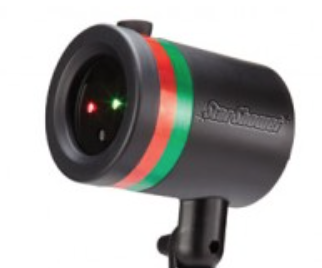
The projector head. It screws into a stake that is placed in the ground for outdoor use.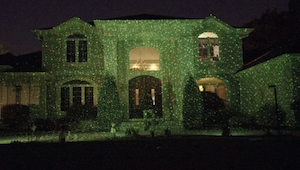
A home densely covered with laser “stars” from multiple Star Shower projectors. Both photos from the Star Shower website.
According to a comprehensive story in Inquisitr, Star Shower is so popular that it is sold out in many locations. TravelPulse calls it a “laser cannon.”
The Federal Aviation Administration on December 8 2015 tweeted “Decorating for the holidays? A stray laser could blind a pilot.” They then provided a link to general information about laser/aviation safety. An FAA spokesperson told CBS Philly, ““I don’t think anybody who buys these devices even think they have enough power to hit an aircraft in the sky…. If the box is aimed a little high, some of the lasers will not hit the roof of the house, they’ll keep going into space.”
While there is no warning on the outer packaging, the Star Shower instruction sheet says: “NOTICE: Lasers should not be projected at or within the flight path of an aircraft within 10 nautical miles [11.5 miles] of an airport. If your intended surface is within 10 nautical miles of an airport, lower the angle of the Star Shower so that no lasers point into the sky.”
In a December 9 2015 statement to NBC Los Angeles, the manufacturer added: “Star Shower Laser Lights operate by taking a single laser beam and diffracting it into thousands of individual laser beams. Each beam emitted by Star Shower is much lower in power than a typical laser pointer. Each individual laser beam is 10 times less than the maximum permissible exposure (MPE) allowed by the FAA normal flight zone (NFZ) criteria.”
In an urban or suburban environment, it is likely that most homes are within 10 NM of some type of airport. It may not be a major metropolitan airport; it could be a small general aviation facility. In a December 3 2015 incident, a Boeing 737 at 13,000 feet and 22 miles east of Dallas-Fort Worth Airport, reported seeing lights from what was believed to be a “laser holiday light display.”
From the FAA, Inquisitr, NBC Los Angeles
Analysis and commentary by LaserPointerSafety.com
ADVICE FOR OUTDOOR USE
After purchasing and testing a Star Shower, here is our summary advice for consumers. Details then follow.
The Star Shower is essentially eye-safe, and does not cause direct interference (glare) with pilots’ vision after about 411 feet. However, a single beamlet can be a distraction to pilots at least 3/4 of a mile away, and possibly further away due to the large number of laser dots aimed into the sky causing a flashing effect.
For this reason, a Star Shower needs to be aimed so that beams don’t go into airspace. You do not want an officer knocking on your door because a pilot saw and reported your home laser projector. While it is unlikely you would be arrested for an unknowing aircraft illumination, federal penalties for laser pointer misuse range up to five years in prison and up to a $250,000 fine.
Putting the projector closer to a house will keep more of the beams on the structure. Similarly, don’t aim it up into a tree unless the tree is very dense, such as an evergreen.
It should also be noted that there are reports such as this and this of Star Showers being stolen from yards. If you put your projector on a roof or up in a tree, aiming downwards, this both helps aviation (no beams going up into the air) and makes it harder to steal the projector. Finally, if you are in a heavy air traffic area, you might want to consider restricting it to indoor use only.
IS A STAR SHOWER LEGAL?
Under U.S. federal law, the Star Shower is legal to own and operate. As a Class IIIa (3R) laser, there are no federal restrictions on its use. The federal law prohibiting laser pointer misuse may not apply, for two reasons. 1) It prohibits knowingly aiming at an aircraft or its flight path, and 2) the law applies to “laser pointers…designed to be used by the operator as a pointer or highlighter….” This definition would not seem to apply to a device that is not a pointer, and is not used “…to indicate, mark, or identify a specific position, place, item, or object.”
A few states or localities may have restrictions on lasers that would affect Star Shower. Since it is not a laser pointer, and is not used for pointing, restrictions that cover laser pointers may not apply (depending on the exact definition). Some selected state and local laws are here.
Common sense says that a person should not stare into the beams, and that they should not be aimed to harass others. Similarly, the beams should not be aimed down a road or up into the sky, where they could interfere with drivers or pilots.
PURCHASING AND PACKAGING
In early December 2015, we purchased a Star Shower for $40 from a CVS drugstore. The box lists a sales website at BulbHead.com, and the distributor as Telebrands. It also says “Made in China.”
Both the box and the device have the proper FDA-mandated laser safety labeling. The device is FDA Class IIIa, meaning less than 5 milliwatts output. There are two apertures, one for 532 nm green laser beams and one for 650 nm red beams. A diffraction grating in front of each laser breaks the single beam into dozens or “thousands” of less-powerful beamlets. In a foggy or smoky environment, it is possible to see the beamlets in the air, but they are too weak to be seen in clear air.
Although the Star Shower has been popular for the Christmas 2015 season, the packaging does not emphasize this. Instead it says the Star Shower is “great for” indoor, landscaping, holiday, winter and summer uses. The advantages are: “No ladders, no hanging, no dead bulbs, no mess — just plug it in.”
TESTING
We took it to laser expert Greg Makhov of Lighting Systems Design Inc. for testing. Keep in mind that he tested just this one sample unit; we assume it is representative of the other Star Showers that have been sold.
Makhov used two different types of power meters, both which could measure in the microwatt and milliwatt region. He found that the maximum power of a single beam was 0.4 milliwatts. The chart below shows details.
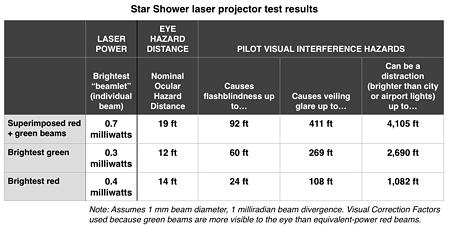
ESSENTIALLY NO EYE INJURY HAZARD
The brightest single beam, at 0.4 mW, is below the 1.0 mW Class II limit. Class II laser pointers are generally considered to be safe for accidental exposure. Eye injury from a Star Shower would be almost impossible unless a person at close range deliberately overcame his aversion to bright light and stared for many seconds into one of the beamlets, keeping it at the same spot in his visual field.
While the chart shows the Nominal Ocular Hazard Distance to be as far as 19 feet, keep in mind this is a “nominal” hazard. This does NOT mean that beams will cause injury at this distance. There is a kind of safety factor built in to the NOHD. A quick approximation is that at about 1/3 the NOHD (about 6 feet in this case), there is a 50-50 chance of a laser kept steady on the eye causing the smallest medically detectable lesion on the retina, under laboratory conditions.
GLARE UP TO 411 FEET, DISTRACTION TO 3/4 MILE
The chart also shows the visual interference hazard distances. For example, a pilot could experience veiling glare (she can’t see past the light) up to 411 feet away from the Star Shower projector. The light does not interfere with vision, but is a mental distraction, up to 4,105 feet away — a little over three quarters of a mile.
The above eye and visual interference calculations are for a single beamlet, for two reasons. First, at aviation distances, only one beamlet would enter the eye at a time. They are not so close together that two separate beamlets of the same color would be within one pupil diameter. The second reason is that even a person is so close to the Star Shower that two separate beamlets enter his pupil, each one will be focused onto a different area of the retina. This means that the beams don’t overlap — they are heating different areas. This is why we are primarily concerned — both for eye safety and for aviation interference — with the hazard of a single beamlet.
Now, when a helicopter flies through the dozens or “thousands” of laser beams, this can be more distracting than a single beam. It is no wonder that a pilot might report the laser display, and have it re-aimed or shut down.
Although an FAA spokesperson said a Star Shower was reported by a pilot who was at 15,000 feet, at this distance any single beamlet would be far below the FAA’s distraction limit. This means any beamlet would be no brighter than surrounding city or airport lights. It could be that the large number of beamlets caused flashes as the aircraft flew through them, and that this flashing was itself a distraction. Either way, no competent pilot at 15,000 feet should have any visual interference from a Star Shower. The only problem could be mental distraction, if the pilot paid more attention to the light than to flying the aircraft.
DISASSEMBLY AND HACKING (UPDATED DECEMBER 2016)
In early December 2016, Julius R. wrote to us wondering about the safety implications of opening the Star Shower and removing the star-creating holographic diffraction grating.
Our Star Shower, purchased in December 2015, has four security screws hidden behind rubber caps. The screws are at the bottom of a 2-1/4” deep shaft that is 5/16” in diameter. The screw head shape is a triangle with a raised dot in the center: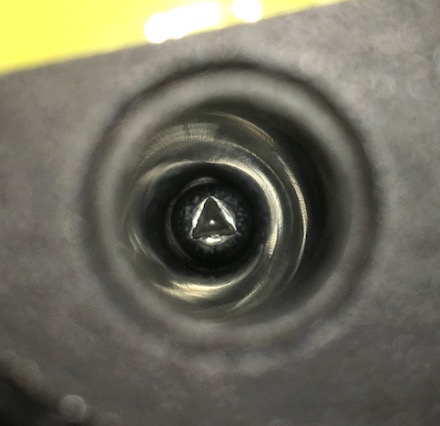
It would require a long screwdriver with a matching tip to reach and undo the screw. A brief search of Google Images to try to find such a screwdriver did not turn up any instances.
Certainly someone might be able to find such a tip, or to grind a shaft to fit. And breaking the Star Shower’s plastic housing could also give access to the inside. So if someone really wanted to get at the interior lasers, it would be possible.
We estimate that each of the lasers on the inside would be in the 10 to 50 milliwatt range. This power can cause an eye injury, although the injury would be relatively minor (assuming an unintentional exposure; deliberate staring into any laser beam should never be done). It is at the low end of Class 3B lasers.
There are similar lasers, and much more powerful ones, readily available online. They would be cost the same or even less, and would be much easier to use. So a laser hobbyist or hacker is unlikely to use a Star Shower as a source for red and green single-beam lasers.
In short, disassembly and misuse of the interior lasers is not a significant safety concern.
FOR FURTHER INFORMATION
Anyone with further questions can contact us; click the link below in the footer at the bottom of the page.
US: "SteadyLaser" pointer said to reduce hand motion
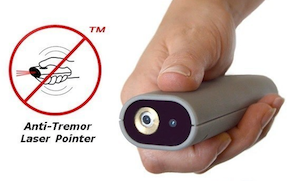
The SteadyLaser
The first version being sold on Kickstarter contains two Class 2 (<1 milliwatt) 635 nanometer red laser modules. The module on the left (in the photo above) is suspended inside the TV-remote sized SteadyLaser. It provides the stabilized beam. The other laser is non-stabilized, like a standard laser pointer. In the final Kickstarter version, the user can choose either either the stabilized beam or the normal beam, but — for safety reasons — not both at once.
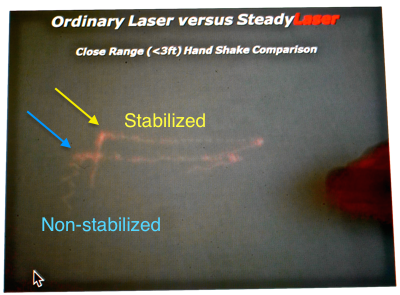
This is a 2-second exposure, from a Kickstarter video, showing both beams being emitted simultaneously in order to demonstrate the stabilization’s effect. The line traced by the stabilized laser is up and to the right of the non-stabilized laser’s line.
Pricing for the initial run of 1000 SteadyLasers is approximately $150 each. It is promoted on Kickstarter solely for presentations in professional locations such as businesses, schools and courts. The primary benefits are claimed to be minimizing distraction, and reducing the appearance of nervousness when using a laser pointer in presentations.
The Kickstarter page first went up approximately April 10 2015. As of April 13 there were 6 backers pledging $960. The goal is to get $150,000 in backing by June 9 2015; otherwise the laser will not become a product — or at least, not through Kickstarter.
Regardless of the Kickstarter outcome, the inventors want to license their patents to current laser pointer manufacturersd.
From SteadyLaser.com, the SteadyLaser Kickstarter page, and Sys-Con Media via PRNewswire
Commentary from LaserPointerSafety.com
There could be concern over a handheld laser that can remain steady on a target. If aimed at an aircraft’s cockpit, the beam would be able to stay in a pilot’s vision longer than a standard, non-stabilized laser pointer.
Because of this potential hazard, LaserPointerSafety.com contacted co-inventor Jeff Wilson, who kindly agreed to add an aviation safety warning to the SteadyLaser’s labeling, with text such as “Do not aim at vehicles or aircraft. This is hazardous and illegal.”
The first-generation SteadyLaser has low power (1 mW) and low apparent brightness (635 nm red, which appears only 25% as bright to the human eye as the common 532 nm green laser). Assuming a 1 milliradian divergence, the SteadyLaser is an eye hazard to 23 feet, can cause flashblindness up to 55 feet from the laser, can cause glare up to 245 feet, and would be a distraction to pilots (brighter than other city and airport lights) up to a half mile from the laser.
However, if future versions had more power — up to the U.S. FDA’s limit of 5 mW for laser pointers — and used a 532 nm green laser, then the hazard distances would increase as follows: eye hazard to 52 feet, flashblindness to 245 feet, glare hazard to 1,097 feet, and distraction hazard to 2.2 miles.
US: FAA says no known permanent eye injuries from laser pointers as of March 2015
Commentary from LaserPointerSafety.com: There have been many pilot claims of eye injuries caused by laser pointers aimed at their aircraft. FAA has investigated some of the most serious claims. In 2011, a person knowledgeable about these studies told LaserPointerSafety (on background): “I haven't seen anything that convinces me that any of the FAA incidents are true injury. I haven't seen any convincing evidence of delayed laser lesion effects. I do know that headaches and eye pain and photophobia and light sensitivity have been reported and associated with laser illumination. I have seen nothing convincing me that there is real cellular, tissue injury.”
There have been a few cases (<10?) of temporary eye injury, where the eye healed. This is similar to how skin can heal after a sunburn. In all of these cases, the pilots returned to flying.
There have also been cases of reported laser injury to the cornea. This is the transparent surface of the eye. Visible laser light passes right through and is not absorbed. The cause of these reported “laser” injuries is the pilot rubbing his or her eyes too vigorously, causing painful scratches in the sensitive cornea. Any damage from a visible laser beam would be on the light-absorbing retina.
Note that FAA limited its statement to commercial pilots. There may be military pilots in conflict zones who have been injured by laser weapons. If so, this information would be classified. Due to the seeming lack of urgency with FAA and U.S. military, any such injuries would not seem to be a threat to commercial pilots in the U.S.
Here are lists of all LaserPointerSafety.com news items tagged with the keyword “eye effect or injury”: aviation injury incidents, non-aviation injury incidents, other eye injury stories.
LaserPointerSafety welcomes any documented cases of pilot eye injuries. Contact us with the links etc., and also contact FAA so they can be aware of the cases.

